Ideas
Random Meditations Through Her 1000 Names - IV
Aravindan Neelakandan
Jul 21, 2018, 08:28 PM | Updated Dec 16, 2024, 01:54 PM IST
Save & read from anywhere!
Bookmark stories for easy access on any device or the Swarajya app.
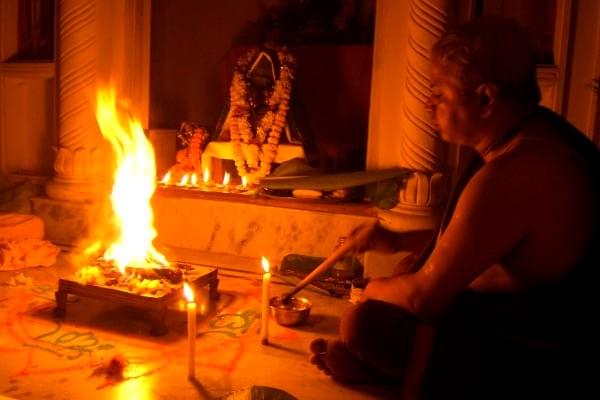
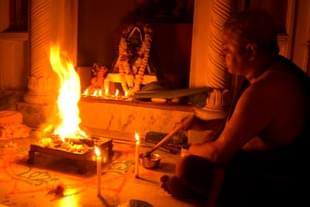
Her fourth name is Chidagnikundasambhuta. Chit is consciousness. Agni is fire. Kunda is the Vedic fire altar. She, the goddess, emerges from the fire of consciousness that is nurtured in the kunda.
In the Puranic context of Sri Lalita Sahasranama, the devas needing to stop Bandasura did a fire sacrifice in order to make the goddess appear and kill the asura. Eventually, they cut out their organs and started offering them in the fire. At this point, the goddess emerged from the agni-kunda. It should be remembered that the Puranas are not fictional or exaggerated stories of the past. They are not past histories. Though they may or may not contain what happened in the historical or physical time. The bifurcation we see between mythology and history in the Euro-centric academia is a result of the history-centric approach of the expansionist religious systems of Christianity and Marxism.
The Puranas can be understood as very similar to the ‘dreamtime’ (Tjukurpa) of Australian aborigines. Tjukurpa is actually not a primitive mythological past time as understood by colonialists and missionaries, but an ever-present spiritual reality that regenerates itself and thus connects the past, present, and future. This matches the definition Yaska (seventh-century BCE) gives for Purana – that, in it the old becomes new.
In the Indic approach to this Puranic event, the account of devas offering their body parts into the fire implies the offering of the subtle-gross-causal body, which creates the ego-related pathos, to the fire Divine. It is at this point that the Divine Feminine emerges from the centre of the Sri Chakra, which, in turn, arose in the midst of “a great blaze of light, bright as millions of suns and cool as millions of moons put together”.
She not only emerges from the fire of the yajna, she also loves the yajna (Yajnapriya 881). She is the one who does the yajna (Yajnakathri 882), the embodied owner of the yajna (Yajamana Swarupini, 883). Above all, she is the yajna itself (Yajnarupa, 769).
When colonial Indologists and their lineage of Indian scholars saw Harappan culture as distinct from Vedic, they needed to invent binaries. So, Harappan culture was considered water-ritual-based and goddess-centric while Vedic culture was fire-ritual-based and patriarchal – dominated by male deities. We studied this in our history textbooks in school. Then, how is that the goddess is so inseparably associated with fire ritual central to the Vedic universe?
Actually, contrary to popular perception, fire altars have been discovered in Harappan sites. Here is a detailed description of these Harappan fire altars as found in Kalibangan by the noted archaeologist B B Lal:
In some of the houses in the Lower Town, a room seems to have been earmarked for features which have been called ‘fire altars’. ... Roughly rectangular on plan with somewhat rounded ends, these measured, on an average, about a meter in length, half-a-meter in width and 25 cm in depth. The sides were pastered with mud. What characteristic is that in each ‘fire altar’ there stood a central stele measuring about 30-40 cm. in height. ... (T)here were several platforms in the southern half of the citadel, but no dwelling houses. On one of the platforms there were seven contiguous ‘fire-altars’, a few of which were however destroyed by a subsequent drain. ... To the north-west of the altars there were a well and a bathing platform suggesting that those who performed presumably had to take a bath. Further behind the row of the altars there was a north-south wall indicating that those who performed the rituals had to face the east. In this context, it may incidentally be mentioned that both the practices, viz. that of having a pre-ritual bath and of facing the east while performing the ritual, are to be noted amongst the Hindus even to the day.“Let not preconceived notions blur our vision: the case of Kalibangan ‘Fire-altars’”, B B Lal, 2015
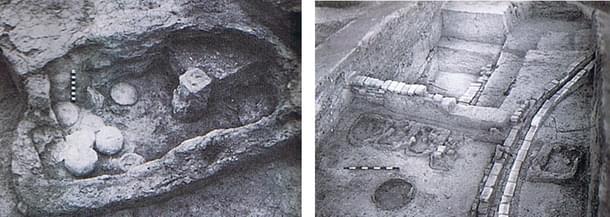
Still, how does one associate the goddess with the Vedic fire ritual, as the Sri Lalitha Sahasranama reveals? Indologist Stella Kramrisch (1886-1993), who belongs to Ananda Comaraswamy-Tagore school, brings out this connection wonderfully.
As Mother Earth, who never lets down, whose lap holds all succor and life immortal, her navel is the center of the earth. This earth to the ancients was but one large altar - for ‘as large as is this altar, so large is the earth’, one sacrificial place where man is restored to primordial unity. The sacrifice is the navel of the universe, the navel of the mother where in the beginning we were together, the place also where Aditi is invoked to restore this our relation. Aditi, Mother Earth, is ritually the altar, who bears in her womb the sacrificial fire. “May Aditi in her womb bear Agni as a mother in her lap, her son” (Yajur Veda 11.57). As altar and womb, the image of Aditi faces upward. .... As earth, womb, and altar, the image of Aditi is surrounded by the waters. The lotus flowers on them. The lotus, symbol of creativeness, blooms above the waters.... The head of Aditi is a lotus for the lotus flower is also above in the sky, where the sun is at the head of the universe (MaUp 6.1.2). The navel of the earth is the center, where the earthly heat is consumed on the sacrificial altar. This is the place of the animal sacrifice, of the creative commutation of animal heat in the flame of the sacrificial fire. There burns the terrestrial fire, Agni, in the flame of the sacrifice. But Agni has sprung from the lotus, “from the head of the Universe” (murdhno visvasya RV. 6.6.13). In these two centers the impartite guiltless Aditi is at one with herself, the Great Mother. For ‘Aditi is heaven, Aditi is the Air, Aditi the Mother, the same also Father and Son’ (RV 1.89.10)Stella Kramrisch, ‘Exploring India’s Sacred Art Selected Writings Of Stella Kramrisch Ed. & With A Biographical Essay’, 1994, p 157
This rather long passage is needed to be quoted here because it brings out a fundamental concept in Indic spirituality that may seem so paradoxical – the basis of the process, the process itself, and the culmination of the process – all are she. In this context, the fire sacrifice, the fire of consciousness, and the emergence of the Divine Feminine that reveals herself in that fire of consciousness – all are one in a fundamental way.
The traditional commentary also brings out another aspect. Her worship is done as an inner mystery. Called Rahoyagam, the 381st name of the goddess itself is Rahoyagakramaradhya – the one to be worshiped by the secret sacrificial rite. Here, the worshipper should realise that the vasanas or the karmic gravitating tendencies of the mind should form the firewood for the sacrificial fire. Jnana (knowledge integrated inseparably with the experience of consciousness) is the flame kindled. All karma done through mind and body are given as offering. She appears in this flame, when adored thus. Krishna also says in Bhagavad Gita that the yajna of jnana is superior to the sacrifice done with physical objects (4:33). Chit-agni or jnana burns away all the karma, declares Bhagavad Gita (4:37).
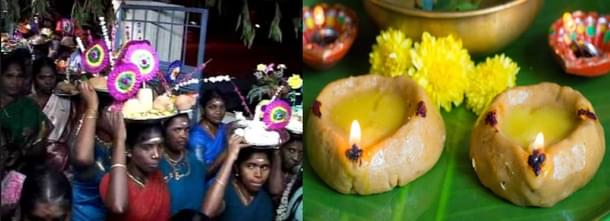
The worship of flame that symbolises the jnana or chit-agni permeates Indian culture thoroughly. The symbolism of the act of lighting and nurturing the fire is repeated in many religious literary cultures of India. Azhwars famously sang of lighting the flame where the whole physical earth becomes a lamp, and lighting the inner lamp where the flame is jnana. In the village and domestic worship of the goddess, it becomes the lighting of mavilakku – or the lamp made of sweet flour. A very popular song sung collectively by common Tamil Hindus explain the significance:
Flour the mind,
Vital breath the plate
Tears of mine the ghee
Burns the ego in the flame
Thus I light my Mother the flour-lamp
The worship of goddess as the fire itself from the earth is seen in the Maha Shakti Peetham of Jwalamukhi in Himachal Pradesh. Local traditions speak of how Mughal emperor Akbar tried to extinguish the fire but could not. It is said that it was the tongue of the goddess which became the flame here. The natural gas from inside the earth being worshiped as goddess connects naturally with the Vedic imagery of earth as the altar carrying inside her the fire. That the tongue, connected with vak, which is also identified with jnana, forms the agni, here is another connection. When one reads this attempt by Akbar to extinguish the flame of the goddess connected to the tongue or vak in India, it is almost impossible not to think of another goddess in another end of the world.
Brighid is the Celtic goddess of flame. She was worshipped as the flame. She was the inspiration of the poets. In her own way, she was chit-agni and her name relates to another name in the Sahasranama – Brhati (673). When Christianity came to the land of Celts and Druid, it tried to tame her into the cult of Jesus by making her a mere saint of the sky-god and his son. So, by 450 CE, she became St Brigid of Kildare. Yet, the church could not extinguish the fire of her worship for almost 800 years. Her holy well, which no men should visit, and her eternal flame continued to burn near Kildare, Ireland, till 1220 CE, when the local Bishop ordered it extinguished. However, it was lit again by local devotees and was again put down in 1550. Then, it was only in 1993, with the revival of Pagan religions in Europe, that her fire would be lit up again.
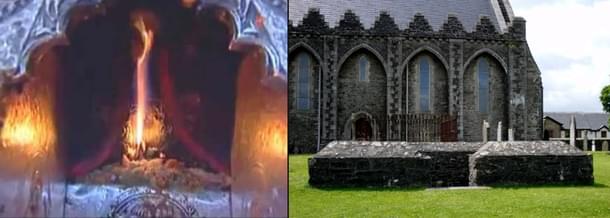
Thus emerges the goddess everywhere from the fire of consciousness, which we keep alive by the sacrifices we make.
Aravindan is a contributing editor at Swarajya.




